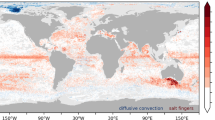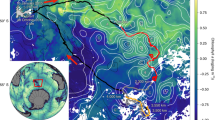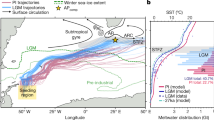Abstract
Thermohaline intrusions have often been observed extending several kilometres from ocean fronts1. They have a central role in models of mixing2,3; however, their origin has been the subject of controversy. Laboratory studies led to the idea that intrusions might be formed by double diffusion4–6, in which case they would slope across isopycnals (surface of constant density). That signature has been identified in ocean fine-structure sections7. Observations of the three-dimensional structure of meandering fronts led to a different conjecture: that intrusions might be formed isopycnically by the ageostrophic circulation within unstable meanders on the frontal jet1,8. In that conceptual model, double diffusion does not initiate intrusions, but may extend and dissipate those created by frontal circulation9. Here we present first the observed structure of such an intrusion and then the results of a dynamical model simulating the isopycnic generation mechanism at an unstable meandering front. We show that thermohaline intrusions formed isopycnically also slope across density surfaces, so there is no need to invoke double diffusion to explain such structures.
This is a preview of subscription content, access via your institution
Access options
Subscribe to this journal
Receive 51 print issues and online access
$199.00 per year
only $3.90 per issue
Buy this article
- Purchase on Springer Link
- Instant access to full article PDF
Prices may be subject to local taxes which are calculated during checkout
Similar content being viewed by others
References
Woods, J. D., Wiley, R. L. & Briscoe, M.G. Deep-Sea Res. 24, 253–275 (1977).
Joyce, T. J. phys. Oceanogr. 7, 626–629 (1977).
Garrett, C. J. phys. Oceanogr. 12, 952–957 (1982).
Turner, J. S. J. geophys. Res. 83, 2887–2901 (1978).
Turner, J. S. in Evolution of Physical Oceanography (ed. Warren, B. A. & Wunsch, C.) 236–262 (MIT, Cambridge, 1981).
Ruddick, B. R. & Turner, J. S. Deep-Sea Res. 903–913 (1979).
Gargett, A. E. J. geophys. Res. 83, 5123–5134 (1978).
Gregg, M. G. & McKenzie, J. H. Nature 280, 310–311 (1979).
Woods, J. D. Ocean Model. 32, 1–4 (1978).
Bauer, J., Fischer, J., Leach, H. & Woods, J. D. Ber. Inst. Meeresk. Univ. Kiel, FRG. No. 143 (1985).
Leach, H., Minnett, P. J. & Woods, J. D. Deep-Sea Res. 32, 575–597 (1985).
Bleck, R. & Boudra, D. B. J. phys. Oceanogr. 11, 755–770 (1981).
Onken, R. thesis Univ. Kiel (1986).
Woods, J. D. & Barkmann, W. Q. Jl R. met. Soc. 112, 1–27 (1986).
Woods, J. D. J. Fluid Mech. 32, 791–800 (1986).
Sawyer, J. S. Proc. R. Soc. A234, 364–362 (1956).
Bleck, R., Onken, R. & Woods, J.D. Q. Jl R. met. Soc.(1986).
Stammer, D. & Woods, J. D. Ber. Inst. Meeresk. Univ. Kiel, FRG(in the press).
MacVean, M. K. & Woods, J. D. Q. Jl R. met. Soc. 106, 293–311 (1980).
Author information
Authors and Affiliations
Rights and permissions
About this article
Cite this article
Woods, J., Onken, R. & Fischer, J. Thermohaline intrusions created isopycnically at oceanic fronts are inclined to isopycnals. Nature 322, 446–449 (1986). https://doi.org/10.1038/322446a0
Received:
Accepted:
Issue Date:
DOI: https://doi.org/10.1038/322446a0
This article is cited by
-
Cyclonic eddies and upper thermocline fine-scale structures in the Antarctic Circumpolar Current
Ocean Dynamics (2019)
-
Seismic imaging of a large horizontal vortex at abyssal depths beneath the Sub-Antarctic Front
Nature Geoscience (2012)
-
Frontal surveys with a towed profiling conductivity /temperature/depth measurement package (SeaSoar)
Nature (1986)
Comments
By submitting a comment you agree to abide by our Terms and Community Guidelines. If you find something abusive or that does not comply with our terms or guidelines please flag it as inappropriate.



